National World War One Museum – Museum Visit
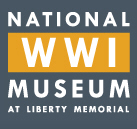 A Visit to the National World War One Museum
A Visit to the National World War One Museum
I am a fortunate man. For a time I lived in Louisiana and was lucky enough to become a docent for the National World War Two Museum in New Orleans. Fate shined a friendly face on me again by locating my in-laws house just about an hour away from the National World War One Museum in Kansas City, Missouri. Fate has had at least one more good card to play on me: my eldest daughter is a blooming military history buff.
So I was only mildly surprised when she announced that not only did she want to visit the National World War One Museum when we were near it (she’d been through the World War Two Museum several times already) but also that she was interested in visiting in 2014 (the 100th year since the war’s outbreak) and also in 2017, the 100th year since the United States entered the war. Unable to fast-forward time, we elected to visit a few days ago. I snapped a few photos and have jotted down some thoughts on the trip.
{default}Approaching the museum is always impressive to me for three reasons. First, it started as a memorial to those who served during the war, and its dedication was in 1921. That’s three years after the war ended. The scars must have still been fresh and deep. Second, the memorial is notable for those who attended its opening. Many of the major players were there, as can be seen from the image below. Foch, Pershing, Coolidge. As an aside, it was one of those days when it was blisteringly hot and humid, with temperatures around 100. This image was taken as we were leaving the cool, dark shelter of the museum. The light was blinding and, frankly, I wasn’t sure these images had even been captured properly until I got home; I simply couldn’t see the screen in the dazzling light. That, too, may be in keeping with the museum’s spirit because surrounding the tower are two Sphinxes with wings covering their eyes: one faces east, remembering the horror of the past, the other faces west, unable to see the future. I could muse for some time on the architecture – folks just don’t make ‘em like they used to. But I won’t. We have more ground to cover.
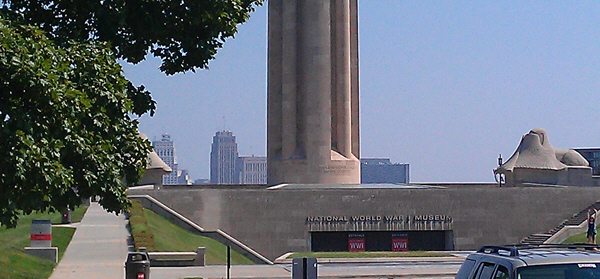
The Sphinx guarding the museum.

Third. Third? Yes, there was a third reason I am impressed with the memorial as I approach it, and let us not forget. The museum sits on a hill to the south of downtown, just above the old train station. This would have been a focal point of every train traveler arriving and departing from Kansas City during that time. It would be as if a memorial were to be placed in the center of Los Angeles Airport today. The location cannot be ignored, even if the means of transport has moved on. For its time, this was intended to dominate the landscape of Kansas City. It still does, for those fortunate enough to enjoy a view from their offices.
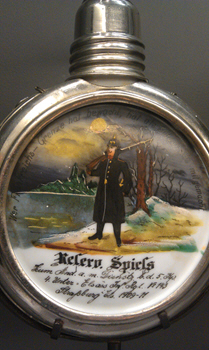
That is just the exterior of the museum. Upon entering and purchasing our tickets, the visitor walks across a glass bridge over a field of poppies. With its origins as a memorial and its expansion as a museum, there are few opportunities lost to combine the wistful poetry of the loss with the hard, matter-of-fact artifacts of a museum.

The first third of the museum is dominated by the tools of war. Rifles, pistols, uniforms, cannons, shells, grenades, machineguns, bullets, airplanes, bombs … it seems to go on without end, as the war must have seemed for those who served in it. It can be easy to be absorbed in the historical collection, the minutia of the evolution of small arms, the wonder at their variety and power and production. Even without a tour guide, passing from the first third of the museum into the second it is impossible to avoid coming to terms with the business end of what all this materiel was aimed at. A huge diorama sits below a balcony, and a ten-minute film unfolds that quietly tells the visitor that Hell … Hell is mud. In a museum some of the grit must be sanitized for the sanity of the visitor. For those seeking a closer view of exactly how mud can turn to Hell, I invite you to read Winston Groom’s account which is one of the recommended books, below.

The final third of the museum is a representation of America entering the war. It is difficult to sometimes comprehend that three years of war unfolded before we Yanks arrived and finally tipped the scales against the Germans. It may also come as a surprise that a strong pro-German current ran through America until a certain Zimmerman Telegram came to light. The artifacts here are again consuming and draw an eerie fascination that can be too easily severed from the reality of their purpose.
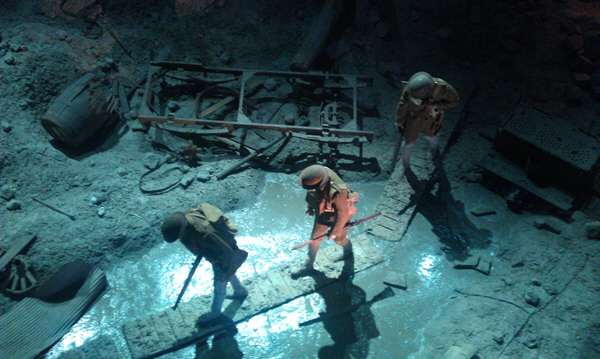
Hell is mud.
But despite the vast array of weapons of war, perhaps my favorite display is tucked away in the small section reserved for the women of the war. I cannot say why, but a simple purple uniform strikes me as angelic. Purple, once the color of kings, must still have been somewhat rare in 1917 I would think, and the woman who wore this … I’d like think she was special. There is also a nurse’s uniform with a simple cape next to it which, again, has an elegance that today would be replaced by function. Those women’s uniforms remain with me far more than the endless rows of guns.
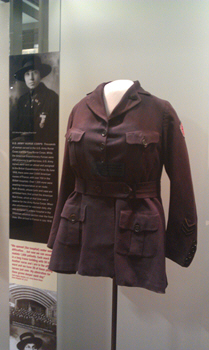
There are other parts to the museum worth note, which the visitor will soon find. There are interactive exhibits, and there are oral histories recorded and available for those who sit down to listen.

An extremely rare German anti-tank rifle, the 13mm Mauser T-Gewehr.
Each time I have visited the National World War One Museum I’ve come away just a bit fuzzy on the reasons for the outbreak of the war. I’m sure that during school I managed to successfully memorize the list given to us – I was always a good student of history. But as an adult I can’t say I can name all the causes for the war. There were many. So this time I paid close attention, hoping to remember them all. And the film told me why the answer was elusive. It, of course, named industrialization, increased awareness of culture, nationalism, alliances, et al. But it told me that, in the end, no one could exactly say why the war happened, which “might be the best explanation of all.” We can layer at least half-a-dozen causes for the war (probably more) but it’s difficult to explain the start of the war without some fairly good pretzel logic. That makes it all the more uncomfortable, for to realize that a war so horrific could start almost without cause, and spread so wildly, should make us quite uncomfortable indeed.

All the more reason to visit the National World War One Museum if you’re in the area. It should not be missed.

To plan your own trip visit the Museum’s official website: http://www.theworldwar.org


Awesome review! The pictures and the account give a good taste of the experience of the museum.
I have seen the monument, but have not been back to Kansas City since the opening of he museum. This really makes me want to go.
Hope you got to eat some amazingly good KC bar-b-que.
Thanks, Airboy.
We did have some fine BBQ. The Museum is impressive. There are huge bronze doors at all the entrances, and be sure to check out the light fixtures on the exterior of the two small outer buildings on top. It’s neat and well worth the time.
Why was WWI fought? In short because Gavrilo Princip shot Archduke Ferdinand in Sarajevo, which led inexorably to Germany invading Belgium.
Princip and his fellow conspirators looked a lot like a tool of Serbia to the Austro-Hungarian Empire, so they made demands (on pain of war) vis a vis investigation that Serbia refused.
Serbia called in their ally Russia.
Austria called in its ally Germany.
Germany knew that a war with Russia would bring in France by treaty and that advanced France was more of a threat than backwards Russia. So they decided to knock France out first.
To support their armies in France Germany needed logistical routes (ie roads and rails) through Belgium.
Attacking Belgium brought in the UK.
I lived in Kc growing up and it is not lost on us locals the privilege we have in this being in our City. The place humbles you instantly and is a tribute to those that endured. Kc has a rich history connected to the War and is a fitting place once you learn why it is placed here. Thank you for doing this memorial and museum Justice in this great article!